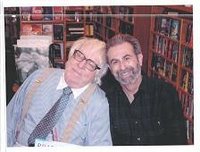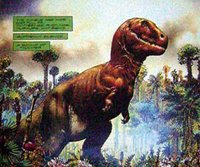But Nolan (pictured left with Forry Ackerman and Ray Bradbury in 1953) was also one of the first to begin keeping detailed bibliographical records of Ray Bradbury's work. In the 1950s, he launched a fanzine/journal called The Ray Bradbury Review. Twenty-odd years later he published a collation of much of this work in a book, The Ray Bradbury Companion. For years, this was the most detailed book on Bradbury's publishing history, and in many respects it is still unsurpassed. Nolan's vast collection of Bradbury materials has been donated to Bowling Green University, Ohio, where it is is accessible to researchers.
Just the other day I stumbled across one of Nolan's earliest Bradbury biblographical pieces, onthe web. FANAC, dedicated to preserving and celebrating the history and publications of SF fandom, has uploaded a 1953 fanzine called Shangri-LA, which includes Bill Nolan's "Ray Bradbury Index".
This particular bibliography is fascinating to me because it captures Bradbury at the peak of his early success: by this time, he had broken out of genre publications and into the "slicks"; he had several books behind him; he had had works adapted for radio and early TV; and he was just breaking into movies. (For more on Bradbury's early experiences of film, see the Spaceman article here.)
"The Ray Bradbury Index" is also remarkable for its detail and accuracy. It gave me cause to cross-check the detail on my own website.
Bill Nolan is still active, and has his own website at www.williamfnolan.com. Last year he was named as Author Emeritus by the Science Fiction and Fantasy Writers of America. And he has been named a member of the Advisory Board of the proposed new Center for Ray Bradbury Studies at Indiana University.










